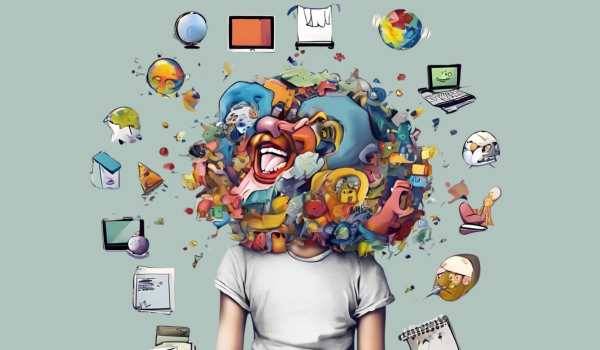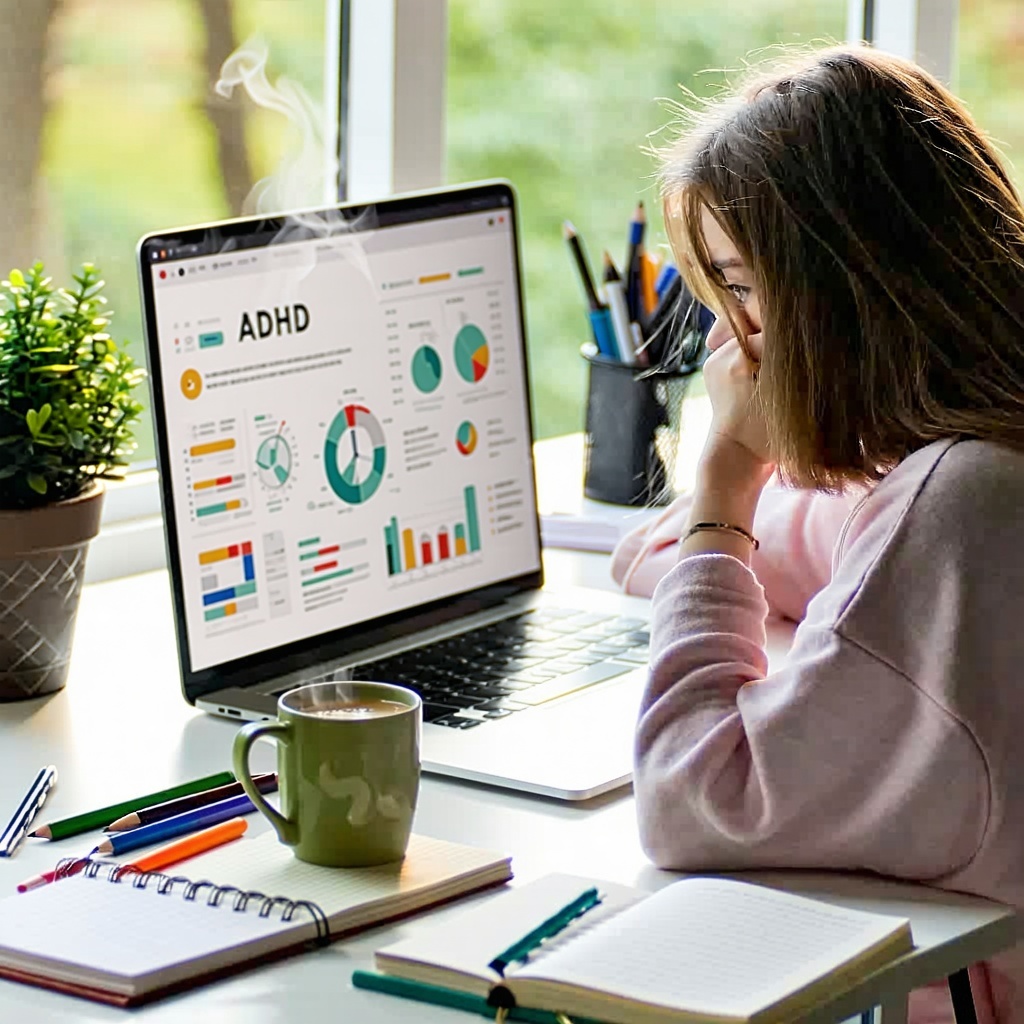School Struggles and Medication: When Learning Feels Harder Than It Should
Let's start with this:If school feels like a daily battle, you're not lazy, broken, or "just not trying hard enough".

ADHD is one of the most well-known and talked about mental health issues in the U.S., but that also means there are plenty of myths out there that need to be busted. Let's explore ADHD, bust those myths, and give you some real information to work with for yourself and your ADHD friends and family.
Attention-Deficit/Hyperactivity Disorder (ADHD) is a condition that affects how a person pays attention, controls impulses, and manages their activity level. While the symptoms of ADHD have been observed for a long time, it was officially recognized as a diagnosis and medical condition by the American Psychiatric Association (APA) in the late 1960s, and the diagnosis got a lot more formal (and it was diagnosed a lot more, too) in the 1980s.
The name "Attention-Deficit/Hyperactivity Disorder" points to the two main "flavors" of ADHD, or collection of symptoms: inattention and hyperactivity/impulsivity. It's important to remember, though, that ADHD looks different for each person.
Hyperactivity/Impulsivity: This is what many people picture when they think of ADHD. This type often involves fidgeting, restlessness, and difficulty staying still.
Inattention: This type of ADHD often means a person struggles with focus and staying on task. They might find it hard to follow multi-step instructions or finish tasks within a set time. For example, someone with inattentive ADHD might doodle during a lecture, have trouble following conversations, frequently ask people to repeat themselves, or put off starting or finishing tasks. They might even be called "lazy" or a "clown" because they try to hide their difficulties with a carefree attitude or by making jokes. Often, they have to work extra hard or take more time to complete things that others find easy. This constant effort can lead to increased feelings of anxiety or depression.
Combined Type: Many individuals experience a combination of both inattentive and hyperactive-impulsive symptoms, leading to a diagnosis of the combined presentation of ADHD. These individuals might struggle with both sustained focus and impulse control, often finding themselves easily distracted while also having difficulty sitting still or waiting their turn.
The most important thing to understand that ADHD is not a character flaw or a sign of laziness. It's a neurodevelopmental condition, meaning it's related to how the brain develops and functions. Research has shown that ADHD has a basis in the brain and often runs in families, which shows just how much genes come into play when it comes to who will and will not be diagnosed with ADHD.
Despite growing awareness, many myths and misconceptions about ADHD still exist. Let's explore some of them:
While discussions about ADHD diagnosis rates are common, evidence suggests that ADHD is often underdiagnosed, especially in certain groups like girls and women.
Diagnosis Rates: In 2022, an estimated 7 million (11.4%) U.S. children aged 3–17 years had been diagnosed with ADHD. This was an increase of 1 million children compared to 2016. Among adults, the rate of ADHD in the U.S. also increased, rising from 0.43% in 2007 to 0.96% in 2016.
Gender Differences: Boys are more likely to be diagnosed with ADHD than girls (15% of boys compared to 8% of girls). However, this doesn't necessarily mean ADHD affects more males; rather, girls' symptoms can be more subtle and less disruptive, leading to underdiagnosis or diagnosis later in life. Girls with ADHD are often more likely to have the inattentive type, while hyperactivity and impulsivity are more commonly seen in boys. Inattentive symptoms in girls might be mistaken for daydreaming or "spacey-ness" and are often overlooked because they don't disrupt the classroom or home environment. Hyperactive or impulsive behaviors in girls might also be misinterpreted as being overly emotional or pushy, leading to diagnoses other than ADHD.
Treatment Rates: Even among those diagnosed, not everyone receives treatment. In 2022, about 30% of children with ADHD did not receive medication or behavioral treatment. About 32% of children with ADHD received both medication and behavioral treatment. This indicates that a significant portion of individuals with ADHD may not be getting the support they need. And these statistics only refer to children in need of help with their ADHD – there are generations of young and elderly adults who have struggled their whole lives without knowing that help was (and still is) an option.
ADHD is a real, recognized medical condition with a neurobiological basis. It's not a matter of willpower or a child just needing to "try harder."
Historical Recognition: Symptoms of ADHD have been described as early as the late 1700s. In 1902, Sir George Frederic Still observed a group of children who were easily distracted, inattentive, and struggled with self-control, noting that these symptoms were unrelated to intelligence. Over time, understanding shifted from viewing these behaviors as character flaws to recognizing them as a result of brain activity.
Brain Differences: Research continues to uncover the ways ADHD affects brain function. For example, ADHD is often linked to lower levels of certain brain chemicals like dopamine and norepinephrine, which play a role in attention, focus, and motivation. Stimulant medications, a common treatment for ADHD, work by increasing these brain chemicals.
Impact on Daily Life: ADHD can significantly affect a person's ability to succeed in school, work, and relationships. Difficulties with executive functions-the brain's ability to plan, focus, and carry out tasks-are a major sign of ADHD. These challenges are real and can lead to considerable distress and functional impairment.
Telling someone with ADHD to "just focus" is like telling someone with poor vision to "just see clearer." It doesn't address the underlying neurological differences.
Challenges with Focus: Individuals with ADHD often struggle with maintaining focus, especially on tasks that aren't inherently interesting to them. This isn't a lack of desire but a difficulty in the brain's ability to regulate attention.
Hyperfocus: Interestingly, people with ADHD can sometimes experience "hyperfocus" on topics or activities they find highly engaging. While this might seem contradictory, it's another aspect of how their attention system works: it can be hard to shift focus away from something intensely interesting, or to engage focus on something uninteresting.
Procrastination and Task Initiation: Many individuals with ADHD experience "early morning procrastination" or difficulty getting out of bed and starting tasks. This can be due to disrupted sleep patterns and challenges with task initiation, which are common ADHD symptoms. The brain's preference for immediate gratification can also lead to delaying sleep to do more enjoyable activities like watching TV or playing video games.
Myth 4: ADHD Medication is Dangerous or Addictive
ADHD medications, particularly stimulants, are generally considered safe and effective when used as prescribed and under medical supervision.
Types of Medication: The two main types of medications for ADHD are stimulants and non-stimulants.
Stimulants: These are often the first-line treatment for ADHD. They work by increasing the levels of norepinephrine and dopamine in the brain, which can help improve focus and attention. Common stimulant medications include Adderall, Ritalin, Vyvanse, and Concerta, among others. They come in immediate-release (short-acting) and extended-release (long-acting) forms, allowing for flexibility in managing symptoms throughout the day.
Non-stimulants: These medications work differently than stimulants and may be used if stimulants are not effective or cause intolerable side effects. Examples include Strattera, Qelbree, Intuniv, and Kapvay. Non-stimulants may take 4-8 weeks to show noticeable improvement.
Side Effects: Like all medications, ADHD drugs can have side effects. Common side effects of stimulants can include increased heart rate and blood pressure, reduced appetite, and difficulty sleeping. Non-stimulants like Strattera can cause nausea and stomach upset, while others may lead to fatigue and lower blood pressure. It's important to discuss any side effects with a healthcare provider. If a person feels jittery, experiences significant weight loss, or aggression, it may indicate that the dose is too high or the medication is not suitable.
Addiction Concerns: There's a common concern that ADHD medication can lead to substance abuse. However, research largely shows that stimulant medication does not increase the risk of substance abuse. Some studies even suggest that treating ADHD with medication can reduce the likelihood of developing a substance use disorder. People with untreated ADHD are actually two to three times more likely to abuse substances than those without the condition, often due to impulsivity and self-medication to manage symptoms.
While ADHD symptoms can change as a person gets older, ADHD is a lifelong condition for many individuals.
Persistence into Adulthood: The understanding that ADHD symptoms don't always disappear in adulthood was recognized in the fourth edition of the Diagnostic and Statistical Manual of Mental Disorders (DSM) in 1994. The most recent edition (DSM-5, published in 2013) now refers to the different types of ADHD as "presentations" that can change over time. There is some emerging research showing that for many undiagnosed women, their ADHD symptoms became more intense as they aged and approached menopause, with other interesting research discussing the intricate interaction of hormones throughout the menstrual cycle on both ADHD symptoms and the effectiveness of medication during those changes.
Adult ADHD: Approximately 4.4% of U.S. adults are reported to have ADHD. Adults with ADHD may continue to experience challenges with attention, organization, impulsivity, and emotional regulation.
Comorbidity with Other Conditions: ADHD frequently co-occurs with other mental health conditions, and these comorbidities can persist into adulthood.
Autism: Recent literature reports that between 50-70% of autistic people also struggle with the symptoms of ADHD, with some suggesting that the overlap between these diagnoses being so high that we may very well be seeing different presentations of one disorder, not two separate ones.
Anxiety and Depression: About 80% of people with ADHD will have at least one other psychiatric disorder in their lifetime, with anxiety and depression being the two most common. Approximately 30% of individuals with ADHD will experience a depressive episode, and 20-30% will struggle with a clinical anxiety disorder. Symptoms of ADHD like emotional dysregulation and executive dysfunction can sometimes be mistaken for anxiety or depression, or contribute to their development.
Substance Use Disorder (SUD)
: ADHD is strongly linked to SUD, with individuals with ADHD being more likely to abuse drugs and alcohol as a method of self-medicating. Substance use among undiagnosed ADHDers often starts at an earlier age than their non-ADHDer peers.
Learning Disabilities: Many children with ADHD also have learning disabilities (LDs), such as dyslexia (difficulty with reading), dyscalculia (difficulty with math), or dysgraphia (difficulty with writing).
Eating Disorders: Recent studies suggest that up to 20% of children with ADHD may also develop eating disorders, including anorexia nervosa, bulimia nervosa, and binge eating disorder. Impulsivity associated with ADHD may play a role in these eating behaviors.
As a Board Certified Psychiatric Mental Health Nurse Practitioner, I often hear from people who wonder if their struggles-or those of someone they care about-might be related to ADHD. It can be confusing when you're constantly trying to focus, stay organized, or manage impulses, and it feels like everyone else has it figured out. You might be putting in extra effort, but still falling short, leading to frustration, anxiety, or even depression.
So, who might benefit from an evaluation? If you find yourself consistently facing challenges like:
Difficulty concentrating, even on tasks you know are important.
Frequent procrastination or trouble getting started on tasks.
Feeling overwhelmed by organization or planning.
Impulsive decisions or actions you later regret.
Restlessness or an inner feeling of "always being on the go."
Struggles with time management, often missing deadlines or appointments.
Emotional ups and downs that feel out of your control.
...it might be worth exploring whether ADHD is playing a role. This isn't just about kids; as we've discussed, ADHD often continues into adulthood. Many adults discover their ADHD later in life, realizing that lifelong patterns of struggle actually have a name and a solution. Similarly, if you notice these patterns in a child, a student, or a loved one, especially if they're affecting their daily life, school, or relationships, it's a good idea to consider an evaluation.
When is the right time for an evaluation? Often, people seek help when these symptoms start to significantly impact their quality of life. Maybe work performance is suffering, relationships are strained, or you're simply exhausted from the constant effort of trying to keep up. There's no "perfect" time, but if the struggles are causing distress or preventing you from reaching your potential, then now is a good time to consider reaching out.
It's important to understand that an ADHD diagnosis doesn't automatically mean medication is the only path forward. An evaluation is a comprehensive look at your symptoms and history to understand what's really going on. If ADHD is diagnosed, treatment plans are always personalized. For some, medication can be a very effective tool, helping to rebalance brain chemistry and make it easier to manage symptoms like focus, impulsivity, and emotional regulation. We have various options, including both stimulant and non-stimulant medications, and we work together to find what works best for you, with the fewest side effects. In fact, when the right medication at the right dose is found, you often see improvements in related issues like anxiety and depression. However, medication isn't for everyone, and it's certainly not the only answer.
Other effective approaches include:
Therapy: Working with a therapist who is well versed in ADHD can help you develop coping strategies, organizational skills, and ways to manage emotional challenges. Sometimes therapy with an ADHD specialist can look like coaching, helping to define the needs and relevant accommodations to make important functioning, like what is required at work and home, more effective.
Lifestyle adjustments: Such as consistent sleep, regular exercise, and a balanced diet, all of which can support brain health.
The goal is always to improve your quality of life and help you thrive. Don't let the myths about ADHD prevent you from seeking the understanding and support you deserve. If this sounds like you or someone close to you, I would love to offer an evaluation and discuss tailored treatment options.
References and Further Reading:
ADHD Data and Statistics:
History of ADHD:
ADHD and Co-occurring Conditions:
ADHD and Substance Abuse: Alcohol and Drugs Connected to ADHD - WebMD
ADHD Symptoms & Treatment: Link Between ADHD, Depression, And Anxiety | BetterHelp
ADHD and eating disorders in childhood and adolescence: An updated minireview
Are Eating Disorders Related to Attention Deficit/Hyperactivity Disorder? - PMC - PubMed Central
ADHD Medication and Treatment:
ADHD in Girls:
ADHD and Sleep:

Let's start with this:If school feels like a daily battle, you're not lazy, broken, or "just not trying hard enough".

Let’s set the record straight: taking medication for ADHD is not a shortcut, a personality transplant, or a moral failure. You’re not trying to...

Let's start with a deep breath.